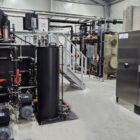The redox potential, also known as the reduction-oxidation potential, is a physico-chemical measured value that describes the oxidation and reduction capacity of a solution. It is expressed in millivolts (mV) and is a key parameter in industrial water and wastewater treatment. The redox potential is used to monitor and control chemical processes, especially those involving electron transfer. Typical applications include disinfection, oxidation of organic substances and the reduction of heavy metals or other pollutants.
Table of contents
Basics of the redox potential
The redox potential is based on the ability of a substance to release electrons (oxidize) or accept electrons (reduce). These reactions take place in an electrochemical equilibrium, which is characterized by the following reactions:
- Oxidation: loss of electrons (e.g. Fe²⁺ → Fe³⁺ + e-).
- Reduction: Gain of electrons (e.g. O₂ + 4e- + 4H⁺ → 2H₂O).
The redox potential is measured using a reference electrode (e.g. Ag/AgCl or calomel) in combination with a measuring electrode (usually platinum). The measurement is carried out under defined conditions such as temperature and pH value, as these parameters influence the redox potential.
Practical significance of the redox potential in water and wastewater technology
1. disinfection
In water treatment, the redox potential is often used to monitor disinfection, especially when using chlorine, ozone or hydrogen peroxide. A high redox potential (e.g. > 650 mV) indicates sufficient oxidizing power, which is necessary to kill germs and pathogens.
- Example of chlorine:
When using chlorine, the redox potential is an indicator of the disinfection performance. Chlorine oxidizes organic compounds and microorganisms, which increases the redox potential.
2. oxidation of pollutants
The redox potential is used in the Fenton reaction, in which iron(II) salts and hydrogen peroxide react to produce hydroxyl radicals (OH-). These radicals oxidize organic pollutants very efficiently.
- Typical target: Degradation of organic substances that are difficult to break down (e.g. in pharmaceutical or chemical wastewater).
3. precipitation and reduction of chromium(VI) to chromium(III) with sodium bisulfite
A special area of application of the redox potential is the reduction of chromium(VI) to chromium(III) in industrial waste water. Chromium(VI) is a highly toxic and carcinogenic heavy metal that occurs in many processes, such as metal processing or surface treatment. In order to comply with legal limits, chromium(VI) is often reduced by sodium bisulphite (NaHSO₃).
Reaction mechanism:
Sodium bisulphite acts as a reducing agent that converts chromium(VI) in an acidic solution into the less toxic and more easily precipitated form chromium(III).
- Chromate ions (Cr₂O₇²-) are converted into chromium(III) ions (Cr³⁺) by electron transfer.
- Protons (H⁺) from the acidic solution support the reduction.
- The resulting chromium(III) can then be removed from the water by precipitation as chromium hydroxide (Cr(OH)₃).
Redox potential monitoring:
The redox potential is a key parameter in this process as it reflects the effectiveness of the reduction:
- Ein niedriges Redoxpotential (< +200 mV) zeigt an, dass genügend Reduktionsmittel vorhanden ist und die Reaktion in Richtung Chrom(III) verläuft.
- Rising redox values indicate that the reduction is incomplete or that additional dosing of sodium bisulphite is required.
Practical implementation:
In practice, sodium bisulphite is dosed in an oxygen-free, highly acidic environment (pH 2-3) to ensure efficient and complete reduction. The resulting chromium(III) is precipitated as insoluble chromium hydroxide by raising the pH to 7-9 and can be removed by sedimentation or filtration.
This process combines chemical dosing, redox potential monitoring and precipitation processes and ensures safe and compliant wastewater treatment.
4. biological wastewater treatment
The redox potential is an important parameter in biological wastewater treatment as it reflects the activity of microorganisms:
- Aerobic processes: High redox values (> 200 mV).
- Anaerobe Prozesse: Niedrige Redoxwerte (< -200 mV).
Targeted monitoring of the redox potential helps to optimize the processes and protect the system from undesirable biological reactions (e.g. sulphate reduction or methane formation).

Photo: Our CP system ALMA CHEM MCW with sodium bisulphite dosing for the reduction of chromium VI
Influencing factors and challenges
pH value
The redox potential is strongly dependent on the pH value, as protons (H⁺) are often part of the redox reactions. For example, the potential of oxygen reduction shifts in alkaline water.
Temperature
As the temperature rises, the reaction rate of the redox processes increases, which can lead to dynamic changes in the redox potential.
Interference from foreign substances
Foreign substances such as organic substances or dissolved salts can influence the redox potential by causing additional redox reactions.
Application of the redox potential in practice
In practice, online measuring systems are used to monitor and control the redox potential in real time. These systems typically consist of:
- Sensors with high chemical resistance (e.g. platinum or gold).
- Control units that define alarm limits and control loops.
Examples:
- Monitoring the dosing of oxidizing agents (e.g. in cooling towers).
- Control of biological reactors in wastewater treatment.
- Optimization of corrosion protection measures in closed water circuits.
Conclusion
The redox potential is an essential parameter in industrial water and wastewater treatment. It enables the monitoring and control of chemical precipitation processes and biological processes and thus contributes to the efficiency, safety and sustainability of modern plants. Engineers and operators benefit from a sound understanding of the redox potential in order to optimize processes in a targeted manner and avoid malfunctions.
For further information on our products, please feel free to contact us at any time!








